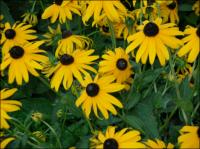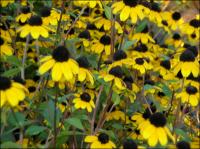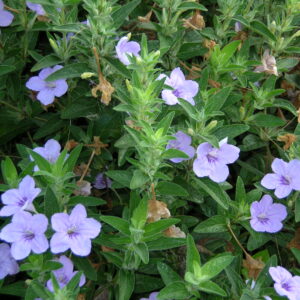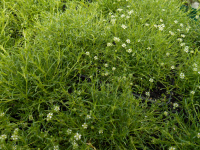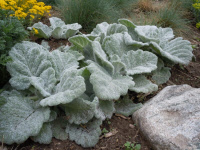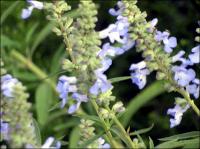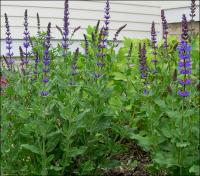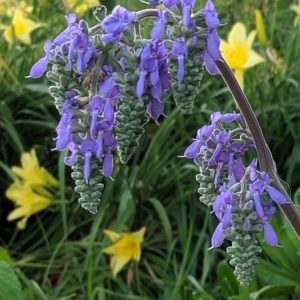Perennials & Biennials
Showing 385–392 of 485 results
-
Rudbeckia subtomentosa Sweet coneflower Z 4-8
These Rudbeckias tower above basal leaves on rigid, branching stems forming clumps of sun yellow petaled flowers surrounding a raised, brown-purple dome of disc flowers.
These Rudbeckias tower above basal leaves on rigid, branching stems forming clumps of sun yellow petaled flowers surrounding a raised, brown-purple dome of disc flowers.
Size: 4-5' x 1-2'
Care: Sun to part shade in moist to moist well-drained soil
Native: East US, Wisconsin native.
Wildlife Value: attracts butterflies, deer resistantRudbeckia was named by Linnaeus for his University of Upsala professor, Olaf Rudbeck. Rudbeck made the surprising claim “that the Paradise of Scripture was situated somewhere in Sweden.” C.F. Level. This species described in 1815. May have been collected by English planthunter John Bradbury (1768-1823).
-
Rudbeckia triloba Branched coneflower, Brown eyed susan Z 3-9
Multitudes of stems, each bearing a small sunny daisy with brown centers at its tip for a sun-drenched crowd from July to October, as cheery as they come.
Multitudes of stems, each bearing a small sunny daisy with brown centers at its tip for a sun-drenched crowd from July to October, as cheery as they come.
Size: 3-4' x 2-3'
Care: sun to part shade in moist well-drained to well-drained soil
Native: most of North America, Wisconsin native
Wildlife Value: Numerous bees, some flies, a few wasps and butterflies feed on the nectar and pollen. One bee feeds only on Rudbeckias and Ratibida flowers.
Awards: Georgia Gold Medal winner. England’s Royal Horticultural Society Award of Garden Merit.Rudbeckia was named by Linnaeus for his University of Upsala professor and founder of the Uppsala botanic Garden, and his son, University of Uppsala professor named Olaf Rudbeck. This species collected in Colonial Virginia in 1600’s.
-
Ruellia humilis Prairie petunia Z 3-9
Lilac open-face trumpets late June-October. Slow to emerge in spring so be patient. One of those non-flashy work-horses, a “MUST HAVE” plant of internationally known garden designer Piet Oudolf. Gardens Illustrated 94 (2013)
Lilac open-face trumpets late June-October. Slow to emerge in spring so be patient. One of those non-flashy work-horses, a “MUST HAVE” plant of internationally known garden designer Piet Oudolf. Gardens Illustrated 94 (2013)
Size: 10-12” x 10”
Care: sun in any soil
Native: Midwest south to Florida and Texas, Wisconsin native where it is endangered.
Wildlife Value: Pollinated primarily by long tongue bees who can reach far into the flower’s throat.Ruellia named for French royal herbalist Jean Ruell (1474-1537.) First collected by Thomas Nuttall (1786-1859) C.1810 English plant hunter who found more American plants than anyone else, early 1800’s.
-
Sagina subulata Pearlwort, Irish moss Z 4-7
Tiny white flowers in summer on extra-miniature grass-like leaves
OUT OF STOCK
Tiniest of white flowers in summer on mound of extra-miniature grass-like leaves.
Size: ½” x 8”
Care: sun to part shade in moist well-drained soil
Native: CorsicaSagina subulata was discussed in Revue Horticole in 1896. The variety aurea extensively used for carpet bedding. H.H. Thomas, 1915. Perfect for rock gardens, between stepping stones on a path or as a groundcover.
-
Salvia argentea Silver sage Biennial or short lived perennial Z 5-7
Large rosettes of the woolliest silver leaves. So soft you want to pet them. Grow this for the leaves, not the flowers. It dies after flowering so cut back flower stems to prevent flowering, or, if you want to save seeds let it flower. It self-seeds sometimes.
Large rosettes of the woolliest silver leaves. So soft you want to pet them. Grow this for the leaves, not the flowers. It dies after flowering so cut back flower stems to prevent flowering, or, if you want to save seeds let it flower. It self-seeds sometimes.
LIMITED QUANTITIES AVAILABLE, LIMIT OF 1 PER CUSTOMER.
Size: 2-4’ x 12"
Care: Sun in well-drained soil.
Native: Europe & No. Africa around Mediterranean
Awards: Royal Horticultural Society Award of Garden Merit; Plant Select® Central Rocky Mountain regionSalvia is from the Latin “salveo” meaning “to heal” referring to the plant’s ancient medicinal uses. Collected before 1750. The Garden reported it was introduced in 1768. Liberty Hyde Bailey said its, “white woolly foliage makes it a very decorative plant.” (1933).
-
Salvia azurea ‘Grandiflora’ Blue sage, Prairie sage Z 5-9
August – October sky blue flower clusters at a time dominated by russet. One of internationally known garden designer Piet Oudolf’s 100 “MUST HAVE” plants, Gardens Illustrated 94 (2013)
August – October sky blue flower clusters at a time dominated by russet. One of internationally known garden designer Piet Oudolf’s 100 “MUST HAVE” plants, Gardens Illustrated 94 (2013)
Size: 4’ x 24-36”
Care: Sun, moist well-drained soil
Native: Southeastern U.S., Wisconsin native
Wildlife Value: Primarily long tongued bees such as Bumble bees visit and pollinate the plants. Host for caterpillars of Hermit Sphinx butterflyNative Americans roasted or popped the seed of Blue sage as a grain. American garden cultivation since 1700’s. William Robinson, father of the mixed perennial border, praised this as “one of the finest (perennials from North America) in its flowers, borne as dense spikes of a beautiful pale blue during September and October.”
-
Salvia nemorosa Meadow sage, Balkan clary Z 5-7
Purple/lavender spire dense with flowers June to September
Dense purple spires flower June to September (if cutback after 1st flush of flowers).
Size: 36" x 24"
Care: full sun in moist well-drained to well-drained soil. Drought tolerant.
Native: Europe to Central Asia.
Wildlife Value: attracts butterflies & hummingbirdsSalvia is from the Latin word salveo meaning “to heal” referring to the plant’s ancient medicinal uses. Collected before 1753.
-
Salvia nutans Nodding sage Z 5-8
Nodding clumps of sky blue flowers high over basal leaves, flower in late spring-early summer.
Nodding clumps of sky-blue flowers high over basal leaves, flower in late spring-early summer.
Size: 3-4’ x 18”
Care: sun to part shade in moist, well-drained soil.
Native: Balkans
Wildlife Value: attracts bees & butterflies seeking pollen and nectar. Deer resistant.Collected before 1753. Introduced to gardens in 1780 by Peter Simon Pallas (1741-1811) Berlin botanist who collected extensively in Russia. Grown in nursery of Joseph Knight, King’s Road, London. Pictured in Curtis’s Botanical Magazine Vol. 50, 1822.

